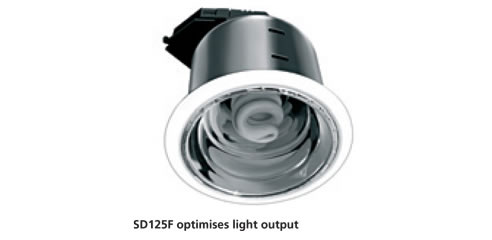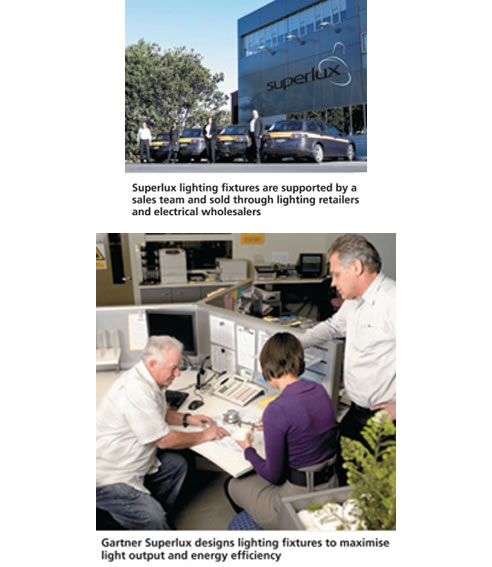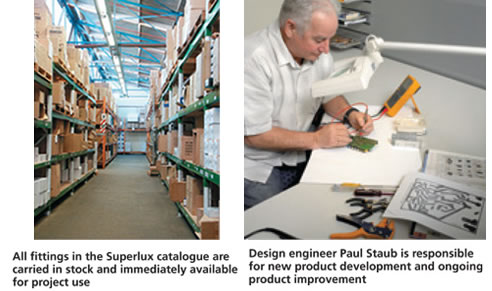NEWS ARTICLE ARCHIVESArtcraft Superlux unlocks CFL performance A compact fluorescent lamp retrofitted in a fixture designed for an ordinary light bulb is about as wasteful as putting high octane fuel in a car not designed for it. It might operate, but it won't deliver the performance everyone expects. That's what engineer John Heimgartner found when he first tested the performance of a CFL lamp replacement in an incandescent downlight - he couldn't believe just how bad the performance was. Tests showed that an extraordinary amount of light was being absorbed in the fixture and the claimed energy savings were being squandered because of the poor light output. As head of Auckland-based lighting manufacturer Gartner Superlux, Heimgartner says the implications were clear: the millions of recessed incandescent light fittings installed throughout New Zealand would perform inefficiently when fitted with a typical energy efficient CFL lamp. To see if this problem could be solved Gartner Superlux committed to more testing and research. Heimgartner says he knew the problem was not the lamps but the inappropriate combination of the lamps and the existing fittings they were going into. In an attempt to boost the light output Gartner Superlux ran tests using a higher wattage CFL lamp in the same fitting. The results were even more extraordinary: the light output went down. "We found that a 20 W lamp not only used 33 percent more power than a 15 W lamp but produced even less light output from the same fixture. Even using the widest diameter fittings output fell from 760 to 737 lumens. This is because the higher wattage bulb is physically bigger and when it is placed in an incandescent downlight the larger fluorescent tube has a shadowing or blocking effect on reflected light." Heimgartner says light reflected back onto a CFL lamp does not pass through it and is lost. "This inefficiency is compounded by poor control of the light that does exit the fitting. Because the fittings are not designed to reflect CFLs, some of the light scatters horizontally instead of vertically and does not get to where it needs to be. "This proved that the performance efficiencies of compact fluorescent lamps would never be achieved in the home unless fittings specifically designed for them were installed as only this would achieve the full potential of both maximum energy savings and maximum light output."
Purpose Designed for CFL's "It is the most effective and efficient residential downlight in New Zealand and is fully optimised for energy saving lamps. It comes complete with a CFL lamp installed and the energy efficiency is locked in. The SD125F cannot be retrofitted with a GLS lamp," says Heimgartner. "The reflector we have designed is highly efficient and enables the use of a 15 W CFL to replace a 100 W incandescent lamp. It produces a 41 percent gain in light output over the same lamp in a incandescent fitting and because light is accurately directed the illuminance achieved is three times higher. "An average house with 20 downlights can save $400 per year by installing SD125F fittings instead of conventional downlights - and they look better too. They come with a range of accessories to add to the aesthetics."
Engineering Approach It is in this area that Gartner Superlux excels, says Heimgartner. "The engineering approach to product development is embedded in the company. Everything we do is underpinned by an engineering mentality. We identify the product performance and features customers want, set the appropriate price points we have to meet, then use our engineering skills to produce the best product outcome." This intuitive understanding of engineering requirements Heimgartner learned at his father's knee. He says his father who began the company in 1955 had a passion for making things well and motivating staff to be highly accurate. It was this passion that has carried the company through a range of hardware products over the years and helped navigate the company through momentous changes in the manufacturing climate in New Zealand. Now one of the few lighting manufacturers to remain, the passion for design is shared by John Heimgartner's daughter who has joined the product development team after completing a Bachelor of Design degree and is now undertaking further education in illumination engineering.
Investment in Quality This means electrical, fire safety and EMC compliance has to be ensured by design, component selection, markings, information and pre-assembly so all electrical contractors have to do is to install them straight from the box knowing all safety and compliance issues are taken care of. The same stringency is applied to lighting performance, says Heimgartner. "We engineer light as much as we engineer the fittings that deliver it. We spent 18 months working on the SD125F reflector just to get the light output right and tried 8 different CFL lamp manufacturers until we found one that could meet our design quality criteria. "The Superlux branded lamps we now supply have a rapid warm up and produce very good lumens per watt. The combined performance is such that we now deliver a light output with a 15 W lamp that competitors' fittings cannot match with a 20 W lamp. "We performance test everything we produce in our own laboratory, then back this up with independent lab testing in Australia." One of the ironies of Gartner Superlux's engineering approach is the disbelief by some specifiers that the luminaires produced by the company can out perform their high priced European counterparts when Superlux pricing is so low in comparison. Heimgartner says he takes it as a complement when he discovers Superlux fittings installed in high profile projects where European quality product was demanded. He attributes much of the success of the Superlux ranges to the strong relationships the company has forged, such as with key Chinese manufacturers of parts and components involved in the construction of the fixtures. "We get a higher level of commitment to quality and precision. They value our engineering input and they listen." He says the other link in the value chain is the success Superlux has found in Australia. "Our export growth has enabled us to fund a high level of R&D and reduce unit prices. As a result we deliver an excellent price for high performance, which is a big win for customers. "With the high level of energy and lighting efficiency we are achieving we are considering switching to energy saving options for all our products." Gartner Superlux offers extensive lighting ranges for residential, decorative and light commercial applications. The company specialises in bringing commercial technology into the reach of residential customers and guarantees a continuity of supply. "We are directly involved in the design and quality decisions of all products in our catalogue and maintain their value through a process of continuous improvement." The company supplies exclusively through lighting retailers and electrical wholesalers. Electrolink ISSUE 73 June - July 2009
|
 |
 |

